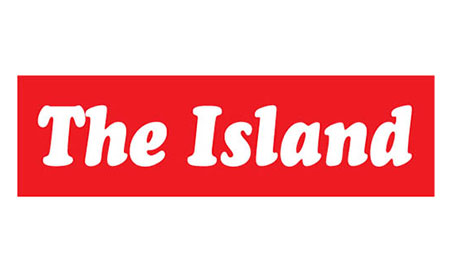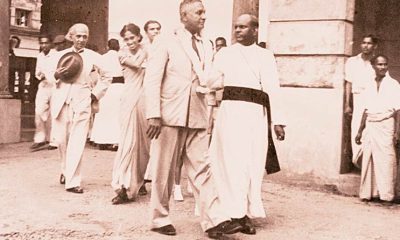Opinion
Are cracks already showing ?

I thank Dr P. A. Samaraweera for giving me the opportunity to explain further why I think the new government is not different from previous regimes. It seems to be better in some respects, in the short term, which is the norm for new regimes, but most seem at best cosmetic. In his opinion piece “Cracks are showing already – a response” (The Island, 8 November), in response to my piece in The Island of 1st November, Dr Samaraweera says, “UW has not offered an alternative. Is he of the opinion that the SJB, the SLPP or Ranil’s crowd would do better?” I do hope the new regime will succeed but with the proviso that it should take constructive criticism and make course corrections. It is not for me to suggest alternatives but comment when things go wrong. In fact, I was among the first to criticise Pohottuwa when things started going wrong, posing the question “Pohottuwa: Will it blossom or wither?”
Though Dr Samaraweera states mammoth crowds are attending NPP meetings, I have seen a number of reports that voter apathy has already set in and groups who helped AKD to win the presidency seem already disenchanted. This is well stated in the editorial, “Tuk-tuk tut-tutting and ground reality” (The Island, 4 November):
‘Many are those who are tut-tutting over the latest fuel price revision, which has not brought any relief to the general public; trishaw drivers, who served as the JVP-led NPP’s grassroots propaganda foot soldiers, as it were, are prominent among them. Quite a few of them are openly critical of the NPP government.’
Corruption comes in many forms, financial corruption being the most talked about in relation to politics. The NPP does not seem to be guilty of this type of corruption yet and seems to be chasing after politicians guilty of this but at the moment it seems to concentrate on illegal vehicles! But it is certainly guilty of the other type of corruption; ‘jobs for cronies’ and the probable protection of those who have question marks raised against them, as well demonstrated by the Ravi Seneviratne-Shani Abeysekara affair!
Ranil appointed two committees on the Easter Sunday bombing towards the end of his term and some have justifiably questioned his motives but these should have been done at the time of the appointment. Udaya Gammanpila has done the right thing by making the committee findings public, a duty that should have been performed by the President who was elected on the promises of transparency and honesty. As mentioned in my previous article, when he was questioned about these at the ceremony presided over by Cardinal Ranjith in the Katuwapitiya Church on 06 October, the President’s evasive answer gave the impression that he had not read the reports but now it transpired otherwise.
Had the new government, which demanded the release of those reports while in Opposition, decided that it did not agree with the findings and decided to ditch the recommendations, it should have done so, before the expose by Gammanpila. Instead, there were implied threats to Gammanpila! Then followed the vilification of him on social media. Worse still were the accusations made against Justice Janaki de Alwis. Gammanpila’s challenge to justify those accusations has been ignored by the government.
The other report from the committee, headed by Justice S. A. Imam, the findings of which were released by Gammanpila, after I wrote my last piece, exposed unverifiability of the UK Channel 4’s claims. No reasons have been given by the government or Cardinal Ranjith, who has now admitted that he was in possession of both reports, for rejecting this report. Is it that they have already decided who the mastermind is and will appoint yet another committee to support their view?
Another interesting question is whether Cardinal Ranjith has let down the Catholic community by his actions. Perhaps, it is best left for that community to decide.
As the De Alwis Committee recommended taking legal action against both Ravi Seneviratne and Shani Abeysekara, can they be a part of a future investigation into the Easter Sunday attacks, even if the government has decided to discard the report. When there is an element of doubt, in a crucial investigation of this nature, should they be allowed to continue in positions where they could influence the outcome? They should have stepped aside till their names were cleared.
Dr Upul Wijayawardhana
Opinion
Valuation Department – a sick giant in deep slumber

Seventy-nine months – six years and seven months – for a file to be cleared by the slack officers in the Valuation Department. Finally, after much effort, in June 2023, a lady officer was cajoled to look into it. The file that was in hiding was retrieved from some deep dungeon and a clerk was directed to work on it. In July 2023, the completed file was sent to the Divisional Secretariat, Kotte. The formal valuation was sent to me – and I detected a serious error in the valuation as the extent of my land given in the document was totally erroneous. Surveyor General official document following surveying the land in 2017, has certified my ownership as 0.0337 HECTARES.
(1 HECTARE IS EQUAL TO 395.3686 PERCHES)
On this basis, the extent of my block of land is 13.3239 PERCHES.
This is the only block of land I own. It is situated off Temple Road in the vicinity of the Open University. I was notified that it had been earmarked for acquisition for Flood Control Project Development purposes by the SLRDC. For the valuation that has to precede the granting of compensation for my land, I had to go through formalities such as repeatedly surveying the land, obtaining legal documents to prove my ownership and several other documents and information connected with it. These procedures have cost me a large sum of money as well as time and hard work. After several months of tedious labour running from pillar to post, SLRDC was satisfied that the requirements are in order.
SLRDC SENT DOCUMENTS TO VALUATION DEPARTMENT IN 2018
Thereafter, the documents were sent from SLRDC to the Valuation Department on January 2nd 2018—more than 6 years ago. The file has been lying on the desk of an officer through all these months. When inquiries were made in 2020 from time to time the officer dealing with my file was habitually late for work, not in her seat, absent for days due to illnesses like ear ache, etc. These were the frivolous excuses given for not attending to my file. She is currently transferred to an office in Maharagama.
Three reminders were sent by SLRDC to Valuation Department to expedite the valuation. Yet, the reminders were totally ignored.
Valuation Department after a very long period of 79 months, has woken up and has sent a valuation that shows the extent as 0.0337 PERCHES with a value stated as Rs.100,000 for the entire extent of 13.3239 Perches. This valuation is totally erroneous and quite suspicious as there seems to be a sinister move to put me off the track and carry out some underhand dealing. Where would anyone get even ONE perch of valuable land in Nawala for that amount?
This is a fraudulent valuation. My file was kept in hiding for over 6.5 years from 02 January 2018 to July 2023. I have been constantly trying to make the Valuation Department work on it – writing to them numerous letters, appeals and personally trying to meet the relevant officers but to no avail. I sent a formal complaint to the Chief Valuer. Never did I receive a response. This is the extremely slack, careless and inefficient manner in which the officers of the Valuation Department discharge their duties. This Department that handles money worth millions needs to be fully overhauled and the entire officers from top to bottom need a thorough cleansing. It is a hell hole of corruption.
I am writing this with great pain of mind and utter disappointment regarding the unexplained huge delay and final careless and fraudulent valuation that is being awarded to me. I am certainly not prepared to accept this minuscule award.
I was also notified that in the event that I do not accept the decision, I could appeal to a Reviews Board. I sent my appeal promptly under registered cover to the Reviewing Board in September 2023. In my appeal I stated that nowhere in the vicinity of Nawala so close to the Open University and other strategic places could one buy even one perch of land for Rs.100,000. This undervaluation shows some hidden agenda which I am certain of. The extent shown on the official valuation is incorrect. It is NOT .0337 Perches BUT .0337 HECTARES.
There are houses alongside mine and professionals residing in the adjoining blocks; this being a highly residential area in the heart of the city. My land has some trees and vegetation. At some moment in time, former president Gotabaya Rajapaksa had in a high-handed manner and without my knowledge or approval dug a trench across my land and another block bordering mine.
Since my appeal to the Reviewing Board, one year has also gone by and the appeals officer also is in deep slumber. I called a few times to see if the matter is being attended to and was vaguely told that they have sent it to SLRDC, Kotte for some further information. When I contacted SLRDC, I was told that the information had been sent promptly. Appeals section lady officer gave vague answers when called again. She is still silent. One does not know who is lying. These are state officials entrusted with providing responsible service to people. The Valuation Department hung onto my file for over 79 months (six and a half and more years) with absolutely nothing being done and now finally a blatant error in extent of the land.
Seventy-nine months is an awful lot of time to deal with many matters that are important to my life. I am sure that these comments of mine are shared by many others whose files are stagnating at the Valuation Department due to the negligence and lackadaisical attitude of the officers from the highest to the lowest in that department.
President Anura Kumara Dissanayake has an Augean task to clean up these filthy, foul- smelling stables, shake the sleeping officers from their deep slumber and get them to work as they should. Replies to letters, correspondence from the public have to be answered promptly is another duty these officers are bound to carry out. In this era of technology, emails could do the job.
When one surfs the website, there are many officers with high-flown credentials but sadly they do not seem to have control over those who hide files for whatever undisclosed reason. Over to the Chief and others in authority at the top to solve this problem of mine as I am at the mercy of slack and careless officers at the Valuation Department. In concluding, I wish to say that valuation means numbers and the officers need to be given basic lessons in Arithmetic, land and area extent conversion tables. They cannot and must not make glaring mistakes in cases such as mine.
M. P. Warusawithana
empeew@gmail.com
Opinion
Need for alternative fuel source

The Middle East conflict is raging. There are reports of one merchant ship being set on fire. If it escalates further, Sri Lanka’s economy will suffer.The cost of fuel amounts to nearly 30% of Sri Lanka’s total imports. There are also fears that the availability of petroleum-based fuels will be over in the world soon.
It is high time Sri Lanka reduced its independence on imported fuel.
Only China is said to be seeking self-sufficiency in fuel viz the production of Butyl alcohol (Butanol). They are said to target 100 million tons to be produced in the near future. Hydrogen is a by-product of producing Butyl alcohol.
It is used to generate electricity through fuel cells. China is said to manufacture about 10% of the fuel cells in the market. The fuel cells were expensive as the critical unit was made out of platinum. A few years ago, the Cambridge University developed a catalyst based on steel to replace the platinum.
Production of butanol, as in the case with ethanol – the alcohol drink- is based on sugar, starch and cellulose.
The raw materials used for producing butanol is corn and in Brazil it is sugar cane. These are two crops that are very expensive to grow and maintain because the plant last only a year and has to be replanted annually.
There are plants available in Sri Lanka, which will last at least 25-30 years once planted, could yield about 1.5 times that of sugar cane. These crops will bear the yield in about 2.5 years after planting. There are also plants that last about 90 years
The only land mass where such plant crops could be grown in one unit is the denuded sugar cane lands at Kantale Sugar Factory. The public should be encouraged to plant sugar cane. They will gain economically from not only planting sugar cane but also from employment opportunities at sugar cane processing centres. My estimation is that about three or four million new jobs can be created as this industry is labour intensive.
Butanol distilleries are not massive structures like the distilleries at Pelwatte, Sevenagala or the old Kantale. Some Universities in the US report regularly on their work on the production of Butyl alcohol. According to the information emanating from those universities, the production facilities are slim and compact.
The technology for the production of Butyl alcohol is not found in Sri Lanka. It is best to seek the assistance of China in this regard.
Butyl alcohol distilleries are said to require four rectifying columns according to technology used in China and this fact is confirmed by a research article published in New Zealand.
There is the possibility of reducing the number of rectifying columns to two.
I have studied numerous research papers on Butyl alcohol production as I have been in the field of alcohol distillation and blending trade for a long time since 1968.
It is necessary to seek external assistance to design and build the distilleries, and it will be necessary to require the assistance of our universities to develop the processing technology to grow and process the plant materials to be used as raw material- mainly Agriculture, Plant Sciences (Botany), Chemical Sciences (Chemistry) and instrumentation. Assistance of the chemical engineering sector can be sought. This would be a profitable exposure to the students therein.
The cost of the studies to be conducted may not exceed Rs 30-40 million.
There is a fabrication factor at Wadduwa- Paiyagala, serving the existing distilleries. Work there is handled manually. Importing the stainless steel and copper pipes and machines to make flanges will help boost production.
The abandoned distillery at Kantale can be used to handle the raw materials in the central and northern parts of the country and many smaller distilleries will be needed in the other parts of the country.
There are state-owned distilleries at Pelwatte and Sevenagala and jointly owned distillery at Hingurana. These distilleries produce ethanol.
It is possible to use the ethanol produced at these distilleries as fuel for diesel-based vehicles after mixing it with additives to enhance its ignitability. A drawback will be the sheer amount of ethanol needed. A better solution is to convert these distilleries to produce Butyl alcohol. The conversion should not be very costly. The government should consider this option earnestly.
S. P. U. S. Wickramasinghe
Former Distillery Manager at Kantale. spupalisw@yahoo.com
Opinion
Sri Lanka’s missed opportunities

As the saying goes, ‘A picture is worth a thousand words.’ The above screenshot was captured on the Flightradar24 flight-tracking app at 0808 hrs on Thursday, November 7, 2024. It shows the number of flight arrivals and departures to/from the Maldives compared to Sri Lanka. The large number of small aircraft are island-hopping floatplanes conveying tourists between the Maldivian capital and the country’s many resort islands.
after all these years, Sri Lanka has still not got its act together with regard to airport usage, falling behind even small countries such as the Maldives.
In Sri Lanka, despite the ‘boast’ of as many as 16 airports, of which five are international gateways, and numerous water-landing sites, domestic aviation is all but dead, especially as an adjunct to Sri Lankan tourist infrastructure. According to a recent OPA (Organisation of Professional Associations) report on domestic aviation in Sri Lanka, the Civil Aviation Authority-Sri Lanka (CAASL) is more ‘obstructive than facilitative’.
Private aviation operators report, with reference to various approvals, that what takes the Maldivian Civil Aviation Authority two days to accomplish takes “a month of Sundays” in CAASL.
The volume of air traffic in the Maldives is so high, a new runway has been constructed and activated at the refurbished Malé-Velana International Airport on Hulhulé island, relegating the pre-existing runway to the status of a parallel taxiway. This obviates the need for aircraft landing on the new runway to backtrack along it to reach the terminal, in turn holding up other aircraft from landing and taking off. A ‘luxury’ that even Mattala Rajapaksa International Airport (MRIA) does not have in place.
Result: a smooth and increased flow of arrivals and departures, with use of the new taxiway (i.e. old runway) ensuring the new runway is available at all times for what it was intended.
But over in Sri Lanka, where are our movers and shakers of aviation tourism? What are they doing to improve aircraft movements at our major international airport? Equally importantly, what are they doing to increase the use of aviation to enhance Sri Lanka’s tourism potential? Are they asleep? Or sitting on their collective hands? Has Sri Lanka missed the (Air)bus?
What a sorry state of affairs!
Guwan Seeya
-

 Features4 days ago
Features4 days agoWhen Sir John Kotelawala visited St. Joseph’s College
-

 News4 days ago
News4 days agoSL will not be able to join BRICS right now but membership of its NDB bank okayed
-

 Opinion7 days ago
Opinion7 days agoA new dawn for Sri Lanka
-

 Sports4 days ago
Sports4 days agoPathum Nissanka; the ace up Sri Lanka’s sleeve
-

 Editorial7 days ago
Editorial7 days agoEuphoria, realpolitik and reality
-

 Features4 days ago
Features4 days agoThe Assassination of Mr Bandaranaike
-

 News2 days ago
News2 days agoHarin drags Messi into poll mess
-

 Features4 days ago
Features4 days agoAmerica stands by its Man!











